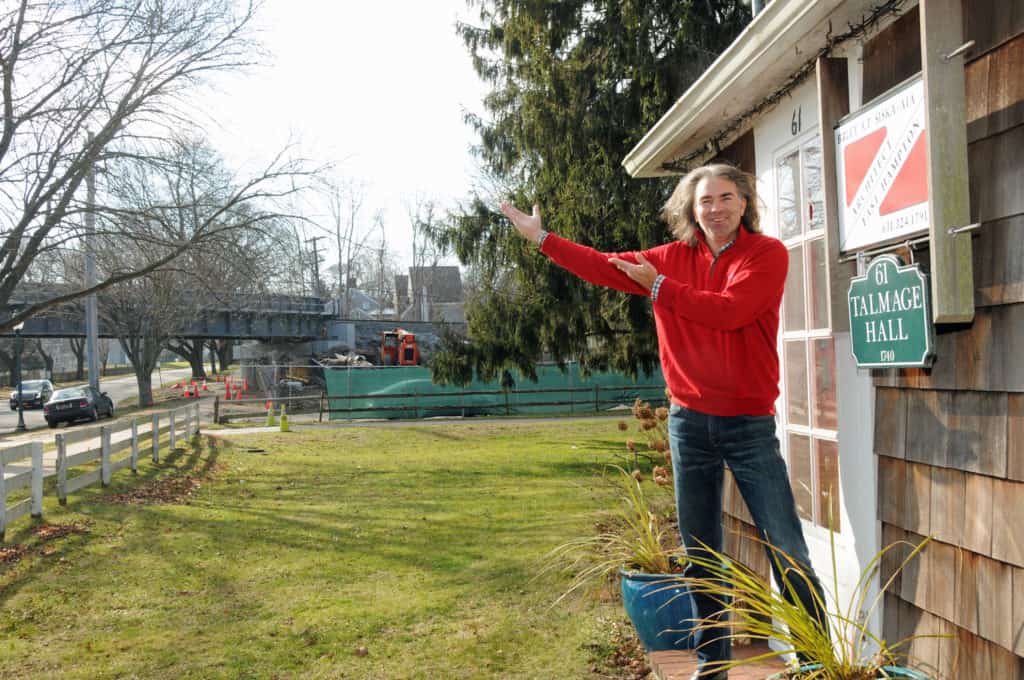If you live or work in East Hampton Village, chances are that North Main Street or Accabonac Road, gateways to Cedar Street, Three Mile Harbor Road and Springs-Fireplace Road, are on your regular route. If so, your driving habits recently had to change, at least temporarily.
Because of the frequency of vehicle strikes into the low clearance overhead railroad bridges on North Main Street and Accabonac Road, it was time for the Village to act, and for locals to find alternate routes of travel.
According to the MTA/LIRR, there were 33 crashes into the North Main Street Railroad Bridge (LIRR #41-0-007), with a posted clearance of 10 feet, and 27 crashes into the Accabonac Road Railroad Bridge (LIRR #41-0-009), with a posted clearance of 9 feet 9 inches, between 2010 and 2019. Bridge reconstruction, safety and stability checks necessarily followed, along with train delays and cancellations.
The entire replacement project took about 18 months and approximately $21 million, including bridge replacement, installation of abutments and retaining walls, and site drainage. Thanks to the expert planning of the MTA/LIRR, the process of bridge removal and replacement took only 23 days.
East Hampton Village was founded in 1648, when farming, fishing and some whaling were parts of everyday life. So, the Long Island Railroad was a relative newcomer when service was extended to East Hampton in 1895, the year the two bridges were constructed. The rights of way taken by the tracks at that time inevitably went through property that had been privately owned for centuries. The homes next to each of the two railroad bridges, the most directly affected by the work, are still occupied by descendants of the same families today.

What is often overlooked in reporting stories of major construction projects, is the human side of the story. Someone lives next door. East Hampton Village Deputy Mayor Barbara Borsack and her husband Ted live in the home next to the Accabonac Road Railroad Bridge, on land that was the Stephen Hedges Farm. Barbara’s ancestry includes the Strong Family and Captain James G. Scott, keeper of the Montauk Lighthouse from 1891 to 1911. She recounted the story of the progression of generations of family home building on Accabonac Road, starting with the house at the corner (actually 15 Pantigo Road) and continuing to the current track location.
Meanwhile, the neighboring home to the North Main Street Bridge replacement has its own historic importance. It is the landmarked 61 North Main Street, the 300-year-old “Isaac Hedges House”, currently the residence of architect Bruce Siska and his family. Bruce’s ancestors, including generations of Talmages, worked on the Isaac Hedges Farm when the house was built. The property fronts on Talmage Lane. Bruce’s sons are Bruce Avery Talmage Siska and Chase Alexander Talmage Siska.
The replacement of the East Hampton LIRR Bridges has been more than just a physical change, but also a “bridge” to a new future in our Village. As Paul Rickenbach, Jr., recently retired Village Mayor after 27 years, describes it, “It seems fitting, as East Hampton Village is on the cusp of 100 years of incorporation, that the recently completed LIRR trestle upgrades represents a tangible reminder of a bygone era. A segue of what lies ahead in the challenges facing our Village — not forgetting the past, while understanding that change is inevitable.”









![Drawing inspiration from the Greek Revival style of architecture, 7 Somers Place was developed by Sag Harbor master builder, Robert Tortora. The gracious living room with mantled masonry fireplace and elevated ceilings flows to the spacious dining room and custom light-filled kitchen. Represented by @thechrisritchey and Kim Hovey of @compass. [link in bio]](https://hamptonsrealestateshowcase.com/wp-content/uploads/sb-instagram-feed-images/488012730_18501545716030135_2576407923807360973_nfull.webp)
![Elegance and intelligence abound at this waterfront masterpiece with 8,065± sq ft, 7 bedrooms and 8.5 baths. 101 Jessup Lane boasts a sweeping double stairway entry hallway, 7 romantic fireplaces, a large gathering room, formal dining room, billiard room, and exercise room with sauna. Represented by @rydbergkent of @douglaselliman. [link in bio]](https://hamptonsrealestateshowcase.com/wp-content/uploads/sb-instagram-feed-images/486626595_18501344173030135_6414454892538890571_nfull.webp)
![Discover fabulous floral finds and nature-inspired treasures to bring beauty and charm to your life. Whether you’re adding a touch of nature to your home or finding the perfect gift, these blooming delights are sure to brighten your day! [link in bio]](https://hamptonsrealestateshowcase.com/wp-content/uploads/sb-instagram-feed-images/487711988_18500839267030135_4881948075500906108_nfull.webp)
![Spring, of course, leads inexorably into another summer season here in the Hamptons. According to agents we spoke to, demand is quite strong this year for rentals. A quality medium-priced property, well presented with amenities, is eagerly sought-after. Publicly listed rentals range from a high of $2.5 million, Memorial Day to Labor Day, on Cobb Lane in Water Mill, with quite a few more $1 million plus rentals than usual. [link in bio]](https://hamptonsrealestateshowcase.com/wp-content/uploads/sb-instagram-feed-images/486541532_18500603206030135_1827695170316201968_nfull.webp)
![Perched atop the dunes at Louse Point sits a picturesque house, perfect for enjoying all seasons that East Hampton has to offer. Situated on three quarters of an acre with almost 360 degree views of Gardiner’s Bay and Accabonac Harbor, 86 & 88 Louse Point are truly unique. Represented by @petrieteam of @compass. [link in bio]](https://hamptonsrealestateshowcase.com/wp-content/uploads/sb-instagram-feed-images/486615712_18500408650030135_1498783920053065135_nfull.webp)
![Set to be completed this year, this extraordinary property spans 2.5± acres of cleared land and showcases over 12,125± sq. ft. of architectural sophistication and refined design. With 9 bedrooms, 11 full baths, and 2 half baths, 261 Millstone Road offers an exceptional blend of spaces for both relaxation and entertainment. Represented by @susan.breitenbach of @thecorcorangroup. [link in bio]](https://hamptonsrealestateshowcase.com/wp-content/uploads/sb-instagram-feed-images/486599655_18500185618030135_8926656954621895711_nfull.webp)

![If you are a buyer searching for an exclusive, brand-new mid or high-rise residence in Naples, Florida, Mystique 601 cannot be missed. Expansive floor-to-ceiling windows invite abundant natural light, seamlessly blending indoor and outdoor living with breathtaking Gulf views. Represented by Mark Riley of @luxepropertiesmia. [link in bio]](https://hamptonsrealestateshowcase.com/wp-content/uploads/sb-instagram-feed-images/486018213_18499791688030135_1711217068426589475_nfull.webp)
